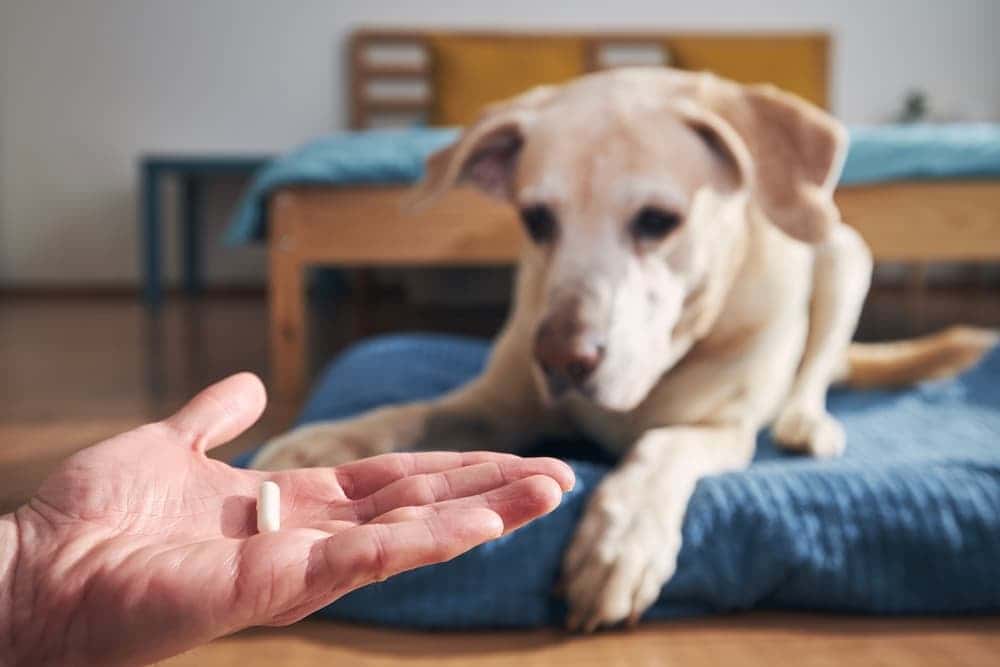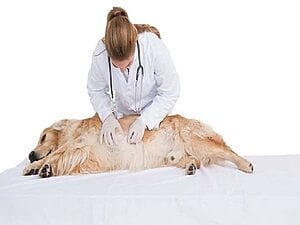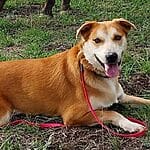Famotidine Pepcid For Dogs: Uses, Dosage, And Side Effects

Famotidine Pepcid For Dogs? What is that?
The generic name for the drug used to treat esophagitis, gastroesophageal reflux disease, and excessive stomach acid production is famotidine, also referred to as famotidine hydrochloride or famotidine HCl (GERD). It is one of the most often prescribed medications in the United States right now and is obtainable both on prescription and over-the-counter. Its brand names are “Pepcid®” and “Pepcid AC®,” respectively.


What Is Famotidine (Pepcid) Quick Facts?
- Famotidine is a histamine receptor-2 (H-2) antagonist and an anti-ulcer medication. Gastric acid is secreted when H-2 receptors (targets) on the cell membranes of stomach cells are stimulated. The medication reduces the formation of stomach acid, giving the ulcer time to heal. Ranitidine (Zantac®), nizatidine (Axid®), and cimetidine (Tagamet®) are additional medications with comparable effects.
- Famotidine works on the chemoreceptor trigger zone to reduce nausea in dogs.
- Pets with stomach ulcers, esophagitis, gastric reflux, esophageal reflux, Helicobacter infections, and/or vomiting can be treated with Pepcid.
- Famotidine may have a decreased effect when used regularly and continuously for an extended period of time, according to studies (more than 14 days). Due to this, it could be advised to take the medication twice daily.
Brand Names for Famotidine
- Only using this medication for human use is registered and FDA approved.
- Pepcid (Merck), Pepcid AC, and other brand names such as Act, Dyspep HB, Pepzan, Arfam, Pamacid, Peptris, Famotren, Famistine, and Fluxid are examples of human formulations.
- Formulations for animals: none
Is Pepcid Routinely Prescribed to Pets?
Although the FDA has not approved this medication for use in animals, veterinarians may legally administer it as an off-label medication. Although famotidine is sold over the counter, it should only be used under a veterinarian’s supervision and direction. One of the 15 human over-the-counter medications that are deemed safe for dogs is Pepcid.
Famotidine Uses in Dogs
There are several uses for famotidine in humans, canines, felines, and other pets.
- Gastric and intestinal ulcers or erosions are treated and prevented with the help of famotidine (shallow depressions in the stomach lining).
- Gastric reflux, also known as acid-reflux disease, is a disorder that causes people to have “heartburn” and is brought on by the flow of stomach acid into the lower region of the esophagus. Drugs like Pepcid are used to treat this illness. It is an excellent medicine for dogs with megaesophagus because it can lessen damage to the esophagus (food tube).
- Treatment for stomach irritation brought on by kidney disease or kidney failure may involve the use of famotidine.
- Mast cell tumors in dogs can create a lot of histamine, so famotidine or a comparable medication may be used to treat them.
- Famotidine is sometimes administered to dogs that have diminished appetites and is used to treat a variety of causes of nausea in dogs. For more information on feeding a dog that won’t eat, click here.
- Famotidine inhibits histamine, therefore it is occasionally used in conjunction with other drugs to treat allergic reactions, such as steroids or diphenhydramine (Benadryl®).
- Numerous conditions that result in stomach issues, ulcers, or illnesses that induce nausea and vomiting are treated with famotidine. Examples include acute pancreatitis, inflammatory bowel illness, and infections like helicobacter or canine parvoviral enteritis.
How Is Famotidine Supplied?
Both prescription and over-the-counter versions of famotidine are offered.
- 10 mg, 20 mg, and 40 mg tablets.
- Oral powder for suspension is supplied at 50 mg/5 ml.
- An injectable with a 20 mg/50 mL or 20 mg/2 mL concentration.
Dogs’ Pepcid Dosage
Never provide medication without first talking to your veterinarian. Before taking Pepcid for dogs, be careful to go through the right dosage and other safety measures with your veterinarian. Every 12 to 24 hours, a dose of 0.25 to 0.5 mg per pound (0.5 to 1.0 mg/kg) of famotidine is often administered. When used for longer than 14 straight days, the impact is lessened. Due to this, it could be advised to take the medication twice daily.
The ailment being treated, how the patient reacts to the medication, and if any negative side effects manifest themselves all influence how long the administration will last. Except as recommended by your veterinarian, make sure to finish the prescription. To prevent a sudden relapse, follow the entire treatment schedule even if your pet feels better.
Tablets should be kept at room temperature and away from light. Formulations that are liquids need to be chilled.
Famotidine Pepcid For Dogs and Potential Side Effects
If you see any of the following adverse effects and are worried that your pet may have consumed a hazardous dosage of medication, call your veterinarian right away:
- Diarrhea.
- Difficulty breathing.
- Difficulty walking.
- Lack of appetite.
- Lethargy.
- Pale gums.
- Vomiting.
To be sure your pet is not exhibiting any of these signs, keep a close eye on them and pay attention to their behavior, urinating, and bowel movements. If you think your pet has swallowed a potentially hazardous amount of famotidine, call your veterinarian right away.
How to Avoid Unintended Exposure to Pepcid
It’s easy for curious animals to get into stuff, and it’s always preferable to avoid poisoning than to deal with it later. To prevent your pets from accidentally consuming a lethal dose of famotidine, take the following precautions:
- All drugs should be kept out of pets’ reach.
- Be especially careful when handling pill bottles and weekly pill organizers. The containers’ design and the noises they create when shaken can resemble toys, luring animals to play with or chew on them.
- Avoid storing medications in plastic bags. Keep your prescription pills safe if you are traveling. Bags are simple to chew through and swallow.
- If you have drugs in your purse, make sure to close it, hang it up, or place it somewhere your pet cannot get it.
- Encourage visitors to keep their possessions locked up and their prescriptions out of the reach of your pets.
More Resources for Pet Emergency
Call the nearest emergency clinic if your pet ingests Pepcid and you are unable to reach your veterinarian. Calling a pet poison control hotline is an additional choice.
The two most common are:
- Animal Poison Control Center of the ASPCA Pet Poison Helpline
- FAQs About Famotidine for Dogs
What should I do if I forget to provide a famotidine dose?
Famotidine can be administered to your dog as soon as you remember to if a dose is missed. However, if it’s almost time for the next dose, only provide the standard dose rather than doubling it.
What is the most important thing I should know about famotidine?
Pepcid belongs to the “H2 blockers” class of pharmaceuticals, which also includes ranitidine and cimetidine (Tagamet) (Zantac). The amount of stomach acid produced is reduced with famotidine. The medicine is generally safe, and overdoses are rare. Pets include dogs, cats, and other animals are frequently prescribed Pepcid.
Before giving famotidine to my pet, what should I go over with my vet?
Before giving your pet any medication, you should talk to your veterinarian about the underlying problem. For instance, if your dog isn’t eating, you should talk about possible causes and come up with a solution. Additional symptoms include vomiting, diarrhea, lethargy, blood in the vomit or stool, and any other anomalies should be kept an eye out for.
Are there alternatives to famotidine?
Famotidine is a member of the “H2 blockers” class of drugs. Cimetidine and ranitidine are two further medications in this class that can also be used in dogs. Alternative medications with better stomach acid suppression include omeprazole, also marketed as Prilosec®. Treatment options for vomiting in dogs, such as cerenia, may be suggested based on their clinical symptoms.
Can you buy famotidine over-the-counter?
Famotidine is available over the counter in several sizes (10 mg is the most common).
What are contraindications to giving famotidine?
Use of famotidine in canines with renal and liver disorders should be cautious. Toxicity is a possibility because these organs process it. Having said that, famotidine is frequently advised, though some dogs may only need to take it occasionally or at a reduced dose.
Is it necessary to give Famotidine Pepcid For Dogs?
Famotidine is best administered without food and on an empty stomach.
What drugs interact with famotidine?
There are few medication interactions with famotidine. The pH change can, however, affect the absorption of other orally taken drugs because famotidine’s main action is to reduce gastric acid. Iron supplements and antifungal medications like itraconazole, ketoconazole, and fluconazole are among these medications.
To maximize famotidine absorption, cephalosporin antibiotics like cephalexin or cefpodoxime should ideally be administered two hours prior to or after. It’s normally advised to wait one hour between oral doses of different medications. The absorption of famotidine can be reduced by several antacids.
What is the difference between famotidine (Pepcid) and ranitidine (Zantac)?
Ranitidine (Zantac) and famotidine (Pepcid) are both members of the group of medications known as H2 receptor antagonists that inhibit histamine.
Between famotidine and ranitidine, there are some physiologic distinctions that include:
- Famotidine is given one to two times per day and ranitidine is given two to three times per day
- Famotidine is eight to nine times more effective at suppression of gastric acid secretion
- Ranitidine has some effect on gastric motility and hepatic microsomal enzyme systems, while famotidine does not
Are Pepcid AC and Pepcid the same thing?
The active component in Pepcid and Pepcid AC is the same (famotidine). While Pepcid is frequently used to refer to the prescription-strength variants, Pepcid AC refers to the over-the-counter, lower-strength form.
Pepcid Complete: What is it?
In the chewable tablet form known as Pepcid Complete®, famotidine and an antacid are mixed. Heartburn symptoms are relieved more quickly (within minutes) by the antacid component than by the famotidine component (peak effect 2 hours).
When is the best time to give famotidine to my dog?
Famotidine should ideally be administered in the morning before breakfast.
Can you crush Pepcid and give it to your dog?
Pepcid should ideally not be crushed. Many tablets are designed to be swallowed and gradually broken down in the digestive system. More of the drug is quickly absorbed when it is crushed.
The oral liquid version (liquid famotidine oral powder for suspension given at 50 mg/5 ml), which is available at most pharmacies, is a preferable option if you are having trouble administering your dog’s medication. Request a prescription from your pet’s physician.
It is preferable to conceal pills in a tiny amount of food, such as canned dog food, chicken, cheese, or peanut butter, as opposed to crushing them. If you can’t accomplish it, you can open your dog’s mouth and put it close to the back. Here are some pointers on how to provide medication to dogs and conceal pills in food.
Which human prescription drugs or over-the-counter (OTC) drugs may I safely give my dog?
Numerous over-the-counter human drugs are suitable for canine use. This list is provided for your reference.
Creator: PetsCareTip










